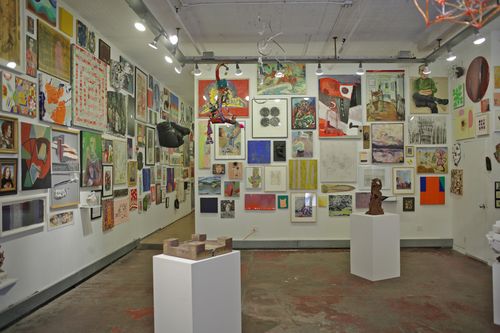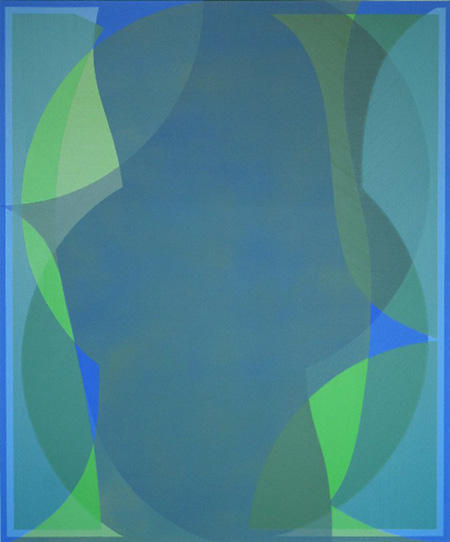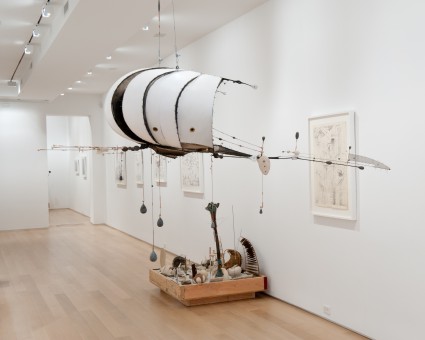
Cathy Nan Quinlan with "My Collection." Photograph by Su Friedrich.
THE NEW CRITERION
January 2012
Gallery Chronicle
by James Panero
On “My Collection” by Cathy Nan Quinlan at www.thetemporarymuseum.com and by appointment in Bedford-Stuyvesant, Brooklyn; “Re-Telling” at Nurture Art, Brooklyn; Ahram Jeong” at Momenta Art, Brooklyn & “Concrete Sound” at Norte Maar, Brooklyn.
Manhattan is the center of the art world. So why schlep to the outer reaches of Brooklyn to see art? My wife has asked me that question more than once on a weekend night, standing on the platform of a subway line we didn’t know existed or waiting to buzz up to an apartment gallery beneath the shadow of a cement plant. So what brings us back weekend after weekend? It’s a good question, and to suggest that we find a pied-à-terre in Bushwick to avoid the hour-long commute back home is not the best response.
Nor does the answer have to do with the appearance of what we see in these out-of-the-way venues. Bushwick, the neighborhood that is now shorthand for New York’s alternative art scene, offers up realism and abstraction, sculpture and painting, all in equal measure. The group shows that make up the bulk of Bushwick’s exhibition program often range across several styles as if refusing to settle on a single look.
While Bushwick lacks a style, I have learned that it shares a substance, in that most of the things you see there are made to take home. Bushwick certainly did not create the commercial art market. It did not invent art that could be purchased, traded, moved, and hung on a living-room wall. Instead, Bushwick’s contribution has been to construct a commercial art scene of its own that is ad hoc and where almost anyone can participate. It offers up art that we can all purchase, trade, move, and hang on our own living-room walls.
Bushwick has gone against the grain, not by turning against the commodities of art, but by turning art into a commodity that is local, much like the many other do-it-yourself craftsmen and cottage industries that have helped this borough become a hub of innovation. By going local, Bushwick does not rail against the art establishment of museums, auction houses, mega-collectors, and celebrity Chelsea galleries. Instead it sets up a viable, alternative culture of arts patronage. Rather than produce large, high-tech, or conceptual work for museums and the rich, it offers up small objects for any wall and every budget. Here the prices asked for individual pieces—in the hundreds of dollars—could not even pay to keep the lights on in a Chelsea gallery. In Bushwick, with art clustered on row-house walls or presented in apartment galleries, the locals make it work. Bushwick’s vitality is in its collectability.
Cathy Nan Quinlan is a painter who for several years has made a side project out of what it means to collect art. Her discoveries, by turns charming, allusive, and funny, can tell us much about the joys of living among the works of artists you know and admire.
From 2005 through 2008, Quinlan ran what she called The ’temporary Museum of Painting (and Drawing) out of her loft apartment in Williamsburg, Brooklyn. With her play on the word “contemporary,” Quinlan aimed “to exhibit and discuss contemporary painting in all its various forms, whether fashionable or unfashionable (at the moment). It is our opinion that a painting, by virtue of its compact, intense stillness, is the perfect object for both contemplation and conversation.”
For Quinlan, The ’temporary Museum was a turnkey institution. One day, she says she decided to invite other artists to exhibit their work in her home. She then put a sign outside and started keeping regular museum hours. She organized exhibitions out of what she called her “Impermanent Collection.” By 2008, she had exhibited ninety-six artists in a space that had become the definition of a local, DIY institution.
When she gave up the lease on her Williamsburg loft to buy a row-house with her partner Su Friedrich, an independent filmmaker, Quinlan closed the museum, but she maintained the website with its record of exhibition programs. Now at her home in the Bedford-Stuyvesant neighborhood of Brooklyn, Quinlan has launched what she calls a “new wing” of The ’temporary Museum called “My Collection.” As we might gather, this wing exhibits the work in Quinlan’s own art collection, which she now hangs salon style in her living room. Following an opening party in December, “My Collection” will be maintained as an online project on The ‘temporary Museum website, redesigned by Friedrich and edited by Barbara Epler, the president of New Directions Publishing.
Quinlan’s website features a page on each work and tells a story about them, much as she might discuss her collection with a friend. “Very little money went into amassing these works;” she explains, “they were mostly gifts and trades, and one or two were just never picked up from shows I curated at The ’temporary Museum.”
Several of the artists here—Sharon Butler, Loren Munk, Adam Simon—will be familiar to the gallerygoers of Bushwick. Others might be new, such as Kurt Hoffman, whose Eastern-inspired landscapes on rice paper, painted en plein air in Central Park, will be exhibited this spring at Valentine Gallery in Ridgewood, Queens.
What distinguishes Quinlan is not only the interest of her collection but also the interesting things she writes about it. “How often I have looked at these paintings while thinking about something else, or glanced at them in passing,” she says. “I have looked at them during arguments, when bored with people or with life, in happiness, misery, and while waiting for the water to boil. I started to think about how different living with a painting is than visiting one in a museum (or gallery) and how pleasurable.”
It is impossible not to see a connection between Quinlan’s collecting project and the paintings she makes in the room next door. The latest series of her work, which will also be exhibited at Valentine this spring, are paintings inspired by the prints of Giorgio Morandi. Some are closely rendered approximations of Morandi’s well-known series of natura morta. Others are more abstract experiments, where the objects nearly become lost in a thicket of painted hatch-marks while also referencing Optical Art and the flickers of a television screen.
Both her collection and her paintings find delight in the pleasures of home. Quinlan understands how art, woven into the fabric of life, can provide another form of domestic comfort. Through The ’temporary Museum, we are fortunate to be invited in to take part in these conversations around a living room filled with art.
Quinlan’s observations come to mind when considering the recent development of a building at 56 Bogart Street in Bushwick. Steps away from the Morgan Street subway station, Bushwick’s arterial node to the not-so-reliable L Train, 56 Bogart is an old industrial loft that recently offered its first floor over to gallery use. Several institutions, some coming in from other neighborhoods, jumped at once to take over this prime space, with over half a dozen galleries and exhibition spaces opening last fall and more to follow. Meanwhile the blue-chip Chelsea gallery Luhring Augustine is turning its nearby back-office into a satellite exhibition space, perhaps signaling the arrival of other established names to a neighborhood that most art-world insiders still cannot locate on a map even if their driver has learned to find the restaurant Roberta’s next door.
Located in the heart of Bushwick, these new spaces present a challenge to the local ecosystem. One issue is whether this new concentration of venues will pull people out into the wider network of apartment galleries or draw resources away from those scattered, shoestring spots. As these ventures set up shop and benefit from Bushwick’s vitality and reputation, the question remains as to how they will mix with the neighborhood’s existing artists and gallery owners and their own institutions, including their network of collectors.
The building’s opening night was Friday, October 21. Gallery 10 hosted a talk with Bushwick habitués Paul D’Agostino, Adam Simon, Sharon Butler, Austin Thomas, Matt Freedman, and Frances Richard on the subject of alternative spaces, artist prices, and the avant garde. A small venue by the building entrance, called Agape Enterprise, plans to exhibit a rotating salon of intimate works, host artist talks, and feature a “gift shop” in the building’s preserved wood-paneled front office, all meant to serve as an antidote to the white-box gallery. Another space, called The Bogart Salon, aims to organize both exhibitions and participatory performances. Its first concept, which offered a live mock-up of Manet’s Déjeuner sur l’herbe (nude model included) and brought artists in to sketch, became something of a spectacle. Meanwhile, down the hall, Interstate Projects presented two video installations by Jesse McLean.
Much attention has been paid to two nonprofits that anchor the building. Nurture Art, known for hosting monthly arts talks and welcoming guest curators, moved from Williamsburg to the basement space of 56 Bogart, opening a few weeks after the other venues. Its inaugural exhibition, curated by Melissa Levin, was called “Re-Telling” and promised “a discreet revision of a history, a landscape, a narrative, a body; often a response to the initial telling being a gross glorification and romanticization.”
The other is Momenta Art—an institution founded in 1986 by Eric Heist, now the proprietor of Agape—that moved from Williamsburg to the first floor. Its opening show featured Ahram Jeong, an artist born in Korea and now living in Brooklyn. In one room, Jeong positioned participants on two carpeted disks, attached heart monitors that activated cameras and flashbulbs, and projected the resulting images on the wall. In another room, she showed videos that recorded the sound of her own heartbeat as she dug a grave, which she translated into digital percussion and notation. She also filmed a drummer interpreting the music from inside the grave pit.
These two nonprofit exhibitions were high concept. Momenta Art’s was high tech. Both seemed out of step with the rest of the neighborhood. In his essay “Museum Without Walls,” André Malraux saw how “the effect of the museum was to . . . divest works of art of their functions. . . . Each exhibit is a representation of something, differing from the thing itself, this specific difference being its raison d’être.” Whatever efforts they made to connect with the local community, these shows seemed too wrapped up in their own raisons.
Across the neighborhood, Norte Maar, Bushwick’s original arts nonprofit and the apartment gallery of Jason Andrew, offered up an exhibition that showed how high concept can interact with the low-tech limitations of the neighborhood. Audra Wolowiec is an interdisciplinary, Brooklyn-based artist who works with sound and created much of the score for Andrew’s ballet “In the Use of Others,” reviewed in these pages in May 2011. For her installation at Norte Maar called “Concrete Sound,” she arranged hundreds of hand-cast tinted sculptures on a table in a pattern that referenced the foam sound insulation found on the walls and ceiling of recording studios.
Rather than absorb ambient noise, Woloweic’s concrete forms resonated with the room’s sound environment, at least metaphorically so. Andrew arranged for local readers to perform around the object. He also commissioned a chapbook featuring the poems of Christine Shan Shan Hou echoing Wolowiec’s statements. In a final resonant note, he underwrote the project by selling off small blocks of the installation to collectors. Now this installation will continue to live through living-room conversations long after the closing of the exhibition.







